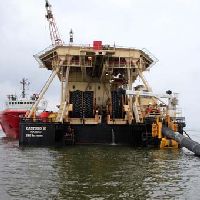Pipelines Pulled Ashore in Germany and Russia
 The construction of the Nord Stream Pipeline continued on schedule over the summer months. In July and August, the two pipe strings constructed near the German and Russian landfall were pulled ashore.Since June 28, the Castoro Dieci has been anchored about 1 kilometre from the landing point, where it has been welding 12-meter-long pipes together to form the pipeline strings.
The construction of the Nord Stream Pipeline continued on schedule over the summer months. In July and August, the two pipe strings constructed near the German and Russian landfall were pulled ashore.Since June 28, the Castoro Dieci has been anchored about 1 kilometre from the landing point, where it has been welding 12-meter-long pipes together to form the pipeline strings.
The two pipe strings that were pulled ashore at the beginning and in mid-July each were about 1,000 metres long weighing 2,000 tonnes. They were individually pulled ashore with the aid of a 100-tonne heavy-duty draw winch mounted on land.
The pipeline strings, supported by large rollers, were pulled into their final position around 250 metres beyond the shoreline. Once the first string was in place, the Castoro Dieci began pipelaying in a northerly direction, slowly moving away from the landfall. When the first pipeline was around 5-kilometres long, it was left on the seabed. The laybarge then returned to the starting point, where it again anchored and began producing the second string, which was pulled ashore in mid July. The first 28 kilometre pipeline segment in German waters is scheduled to be completed sometime this month, then construction will continue on the second string.
The first of the two pipelines built in Russian waters surfaced from the sea onto the Russian landfall at Portovaya Bay on July 28. The pipeline string was pulled ashore from the pipelay vessel Castoro Sei, moored approximately 1.3 kilometres away from the shoreline. The second string was pulled ashore on August 4. In the meantime, construction of the 1.5 kilometre onshore part of the pipeline and landfall facilities is progressing.
As on the Castoro Dieci, the 12-metre long pipes were welded together aboard the Castoro Sei into double joints to form a pipeline string which was then pulled ashore with an onshore anchored winch, with a 121-millimetre diameter wide pull-in wire. The pipeline strings are laid in a trench, which will be backfilled up to the initial seabed level. This will protect the Nord Stream Pipeline from any external impacts, including ice, currents and waves. In order to protect the excavation and limit the sediment spreading, a temporary causeway has been constructed on both sides of the pipeline route in the landfall surf zone.






